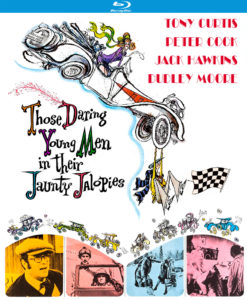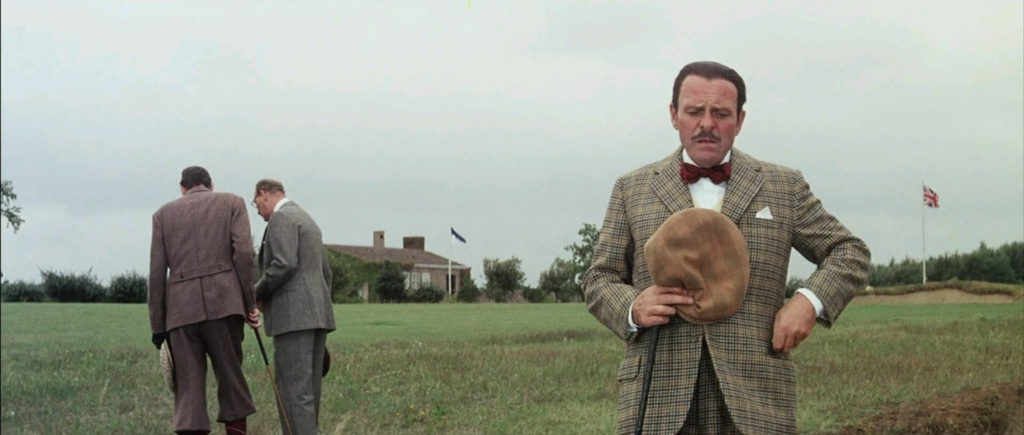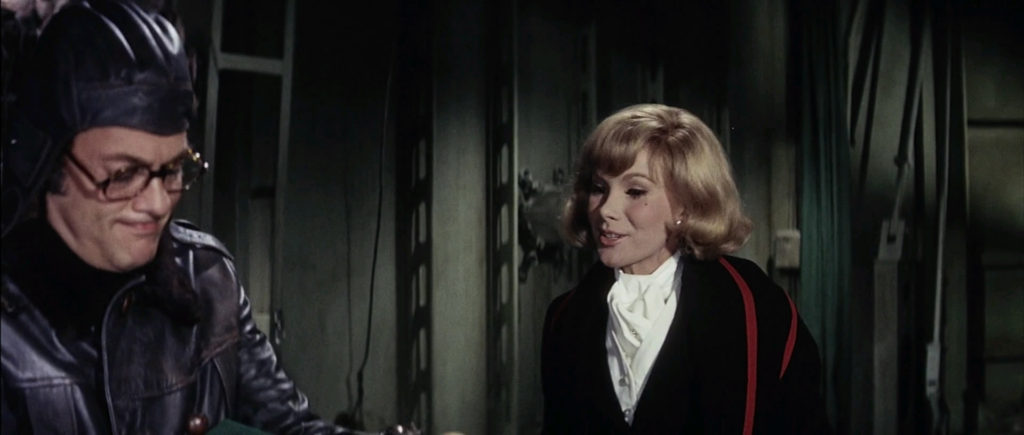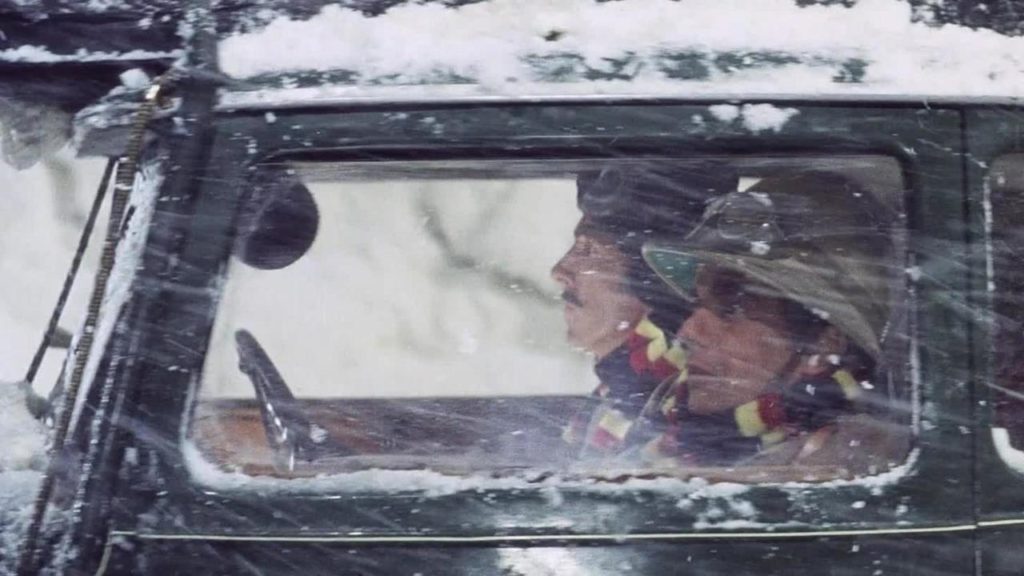It’s A Mad, Mad, Maddening Ride To Epic-length Comedy Obscurity
DIRECTED BY KEN ANNAKIN/1969
STREET DATE: April 25, 2017
 With a title proportionately as lengthy as its running time, Those Daring Young Men in their Jaunty Jalopies began life at the scripting stage as Monte Carlo and All That Jazz before its British producers settled on Monte Carlo or Bust! (The exclamation belongs to the title, not my sentence.) In their superior wisdom, American distributors posited the title I’ll avoid typing again, but which actually better matches the earlier film it followed as semi-sequel, Those Magnificent Men in their Flying Machines (1965).
With a title proportionately as lengthy as its running time, Those Daring Young Men in their Jaunty Jalopies began life at the scripting stage as Monte Carlo and All That Jazz before its British producers settled on Monte Carlo or Bust! (The exclamation belongs to the title, not my sentence.) In their superior wisdom, American distributors posited the title I’ll avoid typing again, but which actually better matches the earlier film it followed as semi-sequel, Those Magnificent Men in their Flying Machines (1965).
The decade that saw It’s a Mad, Mad, Mad, Mad World (’63) and Dr. Strangelove Or: How I Learned to Stop Worrying and Love the Bomb (’64) seismically drop a whole host of kaleidoscopic titles inevitably wore out its brevity-challenged welcome, however, as theater marquees quickly collapsed under their own heavily-weighted verbiage. Even as the film premiered, sadly gone were the days when critics, who may have risked carpal tunnel syndrome with the likes of The Fearless Vampire Killers, or Pardon Me, But Your Teeth are in my Neck and The Persecution and Assassination of Jean-Paul Marat as Performed by the Inmates of the Asylum of Charenton Under the Direction of the Marquis de Sade (both ’67), were able to fulfill the word and space requirements of their reviews simply by typewriting the titles.

Did Jaunty Jalopies (which I’ll henceforth shorten to save my aching fingers) bring the era to a crashing halt? Probably not, but its timing appropriately marks the end of the Swinging Sixties, both by being released in 1969 and rehashing a bigger-is-better comedy style pioneered by Around the World in 80 Days (’56), kick-started in earnest by the aforementioned Mad World, and continued in high-gear through Blake Edwards’ The Great Race (’65). The latter of which, per its title, features a similar premise of vintage automobiles racing through a European period setting, and also shares one of its stars, Tony Curtis, but updates the turn-of-the-century milieu of that film and that of Flying Machines to the late 1920s.

Terry-Thomas returns as the direct descendant of the dastardly English aviator Sir Percy Ware-Armitage, here playing the equally nefarious Sir Cuthbert Ware-Armitage, in an international plot to wrest control of his late father’s auto factory from an interloping American, Chester Schofield (Curtis), by beating him to the locale of at least 2 of the film’s 3 titles. Also en route to Monte Carlo are a pair of British colonials played by Peter Cook and Dudley Moore, a duo of dueling Italians played by Lando Buzzacano (Divorce, Italian Style) and Walter Chiari (Chimes at Midnight), and, rounding out the film’s status as a British/Italian/French co-production, while also contradicting the film’s American insistence on Daring Young Men, a trio of comely and Daring Young French Maids played by Mirelle Darc (Week End), Marie Dubois (Shoot the Piano Player), and Nicoletta Machiavelli (Navajo Joe).
With Gert Frobe, Eric Sykes (both also from Flying Machines), Susan Hampshire (TV’s The Forsyte Saga and The Pallisers), and a top-billed Jack Hawkins – appearing in all of two scenes – one could spend hours delving into the film’s cast list, or researching the technical specifications of the film’s antique cars, but would not get any closer to explaining the film’s appeal or lack. Continuing with a title tune sung by Jimmy Durante, a fun title sequence and cartoon map inserts by the great cartoonist Ronald Searle, and returning Flying Machines director Ken Annakin (Swiss Family Robinson, The Longest Day), admirably tying the film’s many heterogeneous parts to an increasingly unwieldy whole, the film simply reaches the point where 2 hours and 4 minutes of screen time begins to feel more like 4 hours and 2 minutes of screen time, and the title, cast, production, editing, mise en scene – in short, everything on-screen – seem to describe by their curious lack of impact a perimortem for this bigger-than-big, broader-than-broad style of 1960s filmmaking.

Suggested to anyone who wants to witness an era ending, however, Kino Lorber’s Blu-ray rescues this long-lost title from comedy obscurity with a visually-impressive presentation, preserving the anamorphic widescreen images to best advantage on one’s home-viewing mode of choice. An off-the-cuff feature-length discussion between film historians David Del Valle and Jesse Merlin adds entertainment value to the occasionally dry format of the audio commentary, and is particularly valuable for contextualizing Jaunty Jalopies amongst contemporary and more contemporary-feeling movie fare like The Graduate and Bonnie and Clyde (both ’67), despite being released a full two years later. Movies changed to reflect changing times, and the everything-including-the-kitchen sink style was gradually shifting towards a grittier, smaller-scale consideration of the home appliance in question. The grand scale tipped towards social relevance and timely themes, but it’s still nice to look back on a time when millions of dollars could be thrown away simply to stage a narcoleptic Tony Curtis hanging from a snowbound cliff in a teetering Triple S roadster.
Regarding the last point, sometimes a culture’s excesses have as many points of interest as its great insights, while also offering a good deal more entertainment and fun. Only preferably, one hastens to add, in much (much) smaller doses.

The images used in this review are used only as a reference to the film and do not necessarily reflect the visual quality of the Blu-ray.

